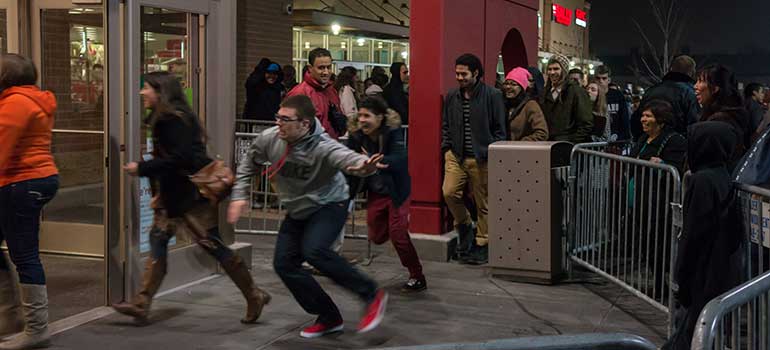
Shopping events like Black Friday and Boxing Day are known to bring out the worst in consumers. Mobs trampling people, physical and verbal assault, robbery, and even shootings have been reported between customers fighting to buy heavily discounted big screen TVs or limited-edition designer shoes.
New research in the Journal of Consumer Research co-authored by Darren Dahl, professor in the UBC Sauder School of Business, finds that aggressive behaviour is primed the moment customers are first exposed to retail ads. In this Q&A, Dahl talks about the psychology of ‘scarcity promotions,’ and what marketers can do to minimize consumer aggression.

Prof. Darren Dahl
Your research is the first to show advertisements lead consumers to behave aggressively even before they reach the store. Why does this happen?
When an ad promotes a limited quantity of TVs or iPhones at an amazing sale price, consumers start seeing other consumers as a potential threat to their ability to buy that product. This threat then provides a base response that can turn into aggression. In our study, participants who were exposed to these type of ads became more aggressive across a number of different experiments; for example, they fired more bullets during a shooting video game, threw more punches while boxing on the Wii, and physically assaulted a vending machine significantly more than the control group when their desired chocolate bar became jammed. One of our experiments even found that exposure to scarcity promotions led to increased levels of testosterone—a hormone shown to be predictive of aggressive behaviour—among participants.
You note that people primed by ads can have the same aggressive reaction to a limited quantity of TVs at Walmart as they do to a shortage of food or water. Why?
This was actually one of the more surprising aspects of the study. Previous research has shown that when people are faced with a shortage of critical life needs like food, water or shelter, they can—and sometimes will—behave more aggressively. Interestingly enough, our research found that the same type of reaction can also manifest itself for products that aren’t necessary for survival—like electronics, which are common sale items during shopping holidays like Black Friday.
Ultimately, this reaction taps into something primal in human beings—participants in our study literally experienced a physiological change that prepared the body to aggress when they were exposed to these types of ads. So, in order to eliminate the perceived threat they felt from other consumers, participants responded with aggression. Could this be due to society’s reliance on technology as a basic need? We can’t speculate.
Can marketers do anything to minimize or even eliminate this aggressive behaviour in consumers?
One of the key takeaways for marketers and retailers is to realize that these types of promotions are associated with a certain level of danger. Retailers in particular should pay close attention to how they manage large promotions in order to minimize the potential for violence—so, that means developing protocols for lineups, ensuring adequate staffing levels, and most importantly, managing the scarcity of the product. Disney’s FastPass at their theme parks is a great example of how these techniques are used to manage a scarce good.
It isn’t all bad news though—our research found that this reaction to product scarcity can be bypassed when consumers realize that certain retail environments won’t accept violent or aggressive behaviour. So what may be OK in a discount store wouldn’t be condoned at Nordstrom.
